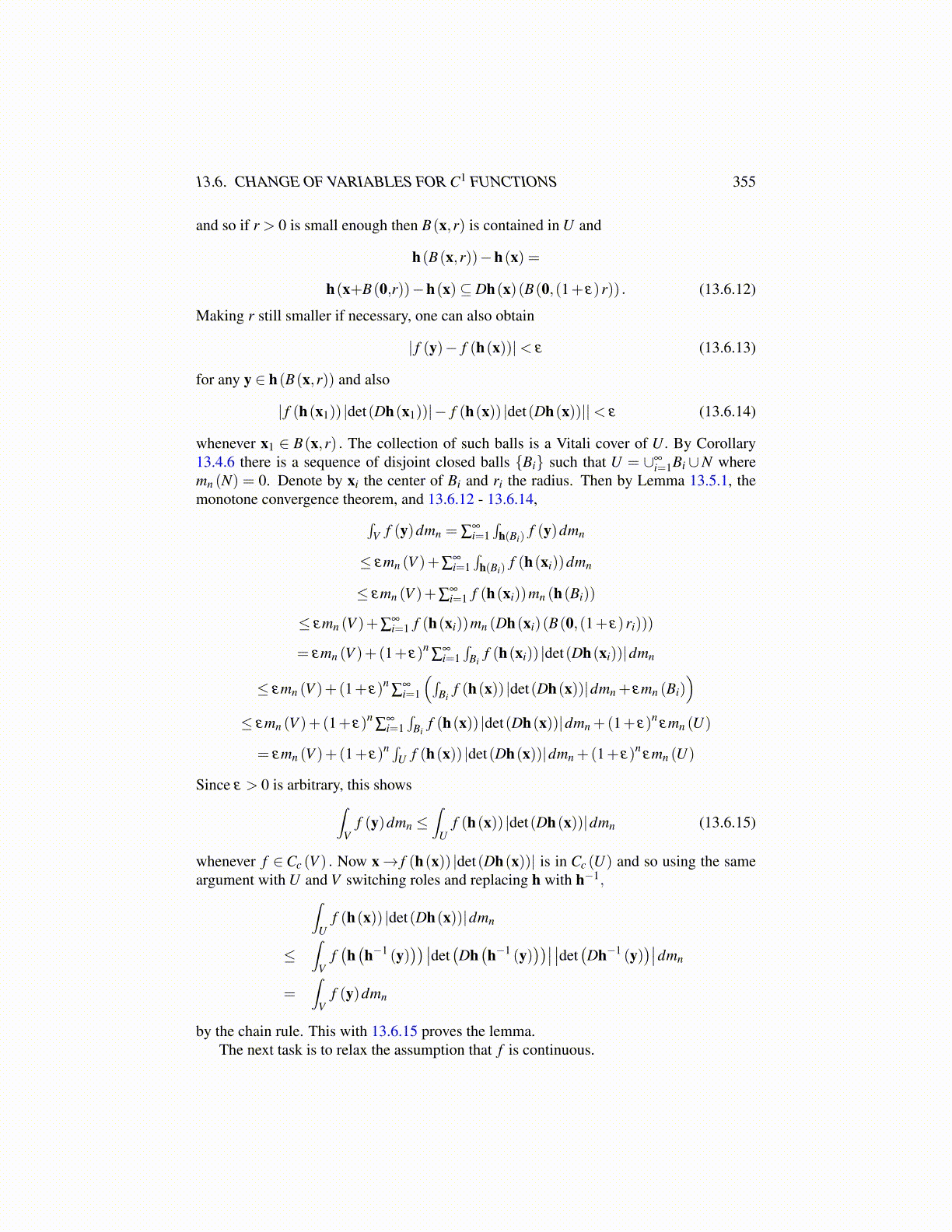
13.6. CHANGE OF VARIABLES FOR C1 FUNCTIONS 355
and so if r > 0 is small enough then B(x,r) is contained in U and
h(B(x,r))−h(x) =
h(x+B(0,r))−h(x)⊆ Dh(x)(B(0,(1+ ε)r)) . (13.6.12)
Making r still smaller if necessary, one can also obtain
| f (y)− f (h(x))|< ε (13.6.13)
for any y ∈ h(B(x,r)) and also
| f (h(x1)) |det(Dh(x1))|− f (h(x)) |det(Dh(x))||< ε (13.6.14)
whenever x1 ∈ B(x,r) . The collection of such balls is a Vitali cover of U. By Corollary13.4.6 there is a sequence of disjoint closed balls {Bi} such that U = ∪∞
i=1Bi ∪N wheremn (N) = 0. Denote by xi the center of Bi and ri the radius. Then by Lemma 13.5.1, themonotone convergence theorem, and 13.6.12 - 13.6.14,∫
V f (y)dmn = ∑∞i=1∫
h(Bi)f (y)dmn
≤ εmn (V )+∑∞i=1∫
h(Bi)f (h(xi))dmn
≤ εmn (V )+∑∞i=1 f (h(xi))mn (h(Bi))
≤ εmn (V )+∑∞i=1 f (h(xi))mn (Dh(xi)(B(0,(1+ ε)ri)))
= εmn (V )+(1+ ε)n∑
∞i=1∫
Bif (h(xi)) |det(Dh(xi))|dmn
≤ εmn (V )+(1+ ε)n∑
∞i=1
(∫Bi
f (h(x)) |det(Dh(x))|dmn + εmn (Bi))
≤ εmn (V )+(1+ ε)n∑
∞i=1∫
Bif (h(x)) |det(Dh(x))|dmn +(1+ ε)n
εmn (U)
= εmn (V )+(1+ ε)n ∫U f (h(x)) |det(Dh(x))|dmn +(1+ ε)n
εmn (U)
Since ε > 0 is arbitrary, this shows∫V
f (y)dmn ≤∫
Uf (h(x)) |det(Dh(x))|dmn (13.6.15)
whenever f ∈Cc (V ) . Now x→ f (h(x)) |det(Dh(x))| is in Cc (U) and so using the sameargument with U and V switching roles and replacing h with h−1,∫
Uf (h(x)) |det(Dh(x))|dmn
≤∫
Vf(h(h−1 (y)
))∣∣det(Dh(h−1 (y)
))∣∣ ∣∣det(Dh−1 (y)
)∣∣dmn
=∫
Vf (y)dmn
by the chain rule. This with 13.6.15 proves the lemma.The next task is to relax the assumption that f is continuous.